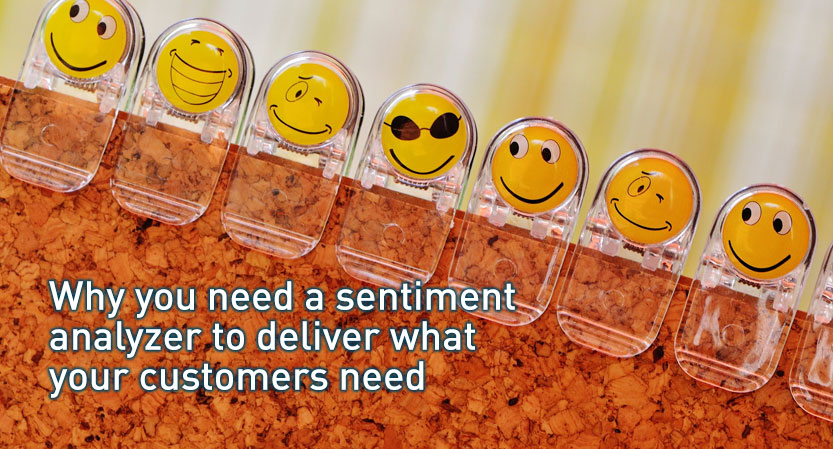
People take purchase decisions based on their perception about a product, service, individual, or entity irrespective of its source, validity, and authenticity. Perception is often born out of a sentiment and can have consequences on a product’s or brand’s credibility and reputation. Thanks to this predominant attribute that drives customer behavior, even a superior quality product can bite the dust in the sweepstakes of business. Moreover, in today’s omnichannel business landscape, sentiment-driven brand perception plays a significant role in achieving business objectives.
Since customer sentiment can either make a product or service acceptable or disowned by its end-users, analyzing the same can accrue key insights for the marketers and help them deliver positive outcomes. Customer sentiment analysis can be made a part of quality assurance process wherein automated tools are used to mine emotions from the text and other channels.
What is customer sentiment analysis?
Sentiment analysis is a process in which opinions of the end-users of a brand, business, product, or service are mined to obtain business-critical feedback. Here, the emotions and attitudes of the end-users are analyzed through their conversations, voice inflections, and language. It is a highly useful tool that can be used in numerous areas, such as on social media platforms to understand customer sentiments on a product campaign.
How does customer sentiment analysis work?
Driven by an algorithm, customer sentiment analysis or customer experience testing strategy measures factors like the level of stress in the voice of a customer and his or her rate of speech to determine his or her sentiment, attitude, and opinion about a product, brand, service, topic, organization, event or individual. It can be used to refine processes and deliver better personalized experiences across channels leading to loyalty, retention, and new customer acquisition.
How customer sentiment analysis can address the customer needs
Testing customer experience is important to enhance the quality of a product or service according to the actual needs of the customer. In today’s competitive business environment where customer experience has become the ultimate determining factor to make a product or service successful, customer sentiment analysis as part of quality assurance cannot be overlooked. The benefits derived from this exercise are as follows:
# Provides customer insight: Businesses need to study the customer experiences to know how their products or services fare in the market. They can do so by employing tools for CX testing and gain insights into what customers think about their products or services. If the sentiments are negative, businesses can identify the reasons or factors behind them and work towards mitigating them. The knowledge of customer sentiments can help businesses to add new features and/or functionalities to their products or services and curate better plans to conduct future campaigns.
# Offers proactive business solutions: Customer sentiment analysis as a part of quality assurance and testing can help businesses to make informed decisions, draw better strategies, and set up realistic targets. Specific tools can offer proactive business solutions in the form of automatic reports, event analysis, etc. These can help businesses to understand the emotions behind positive, negative, or neutral opinions about specific products or services. Furthermore, it can help marketers to evaluate the impact of launch campaigns on customers and identify the specific demographic segment(s) where the interest or awareness about the product or service is the highest.
# Measures the success of any marketing campaign: The measure of any marketing campaign is not limited to the number of likes, followers, or comments alone. It also encompasses the number of discussions (positive or otherwise) elicited by customers about the brand, product, or service. By combining the numerical and non-numerical data generated through customer sentiment analysis, businesses can measure the ROI of their marketing campaign.
# Eliminates gaps in customer experience: Customer sentiments need to be measured holistically and not pigeonholed into multichannel like phone, email, chatbot, social media, etc. In other words, data for customer experience need to be collected holistically for the entire customer journey - initial awareness to repeat purchases. This will help to analyze the data more accurately and aid businesses to remove the gaps in customer experience.
Conclusion
Software quality assurance is not only about enhancing the quality of a product or service during the SDLC. It is also about obtaining data on customer experience by using specific tools for customer sentiment analysis. By determining the customer sentiment about a brand, product or service, businesses can improve their processes, delivery mechanism, not to speak of the quality of products or services. Although it is still an emerging area, businesses should utilize it to know more about their customers and to derive better success with their deliverables.
Author Bio
Oliver has been associated with Cigniti Technologies Ltd as an Associate Manager - Content Marketing, with over 10 years of industry experience as a Content Writer in Software Testing & Quality Assurance industry. Cigniti is a Global Leader in Independent Quality Engineering & Software Testing Services with CMMI-SVC v1.3, Maturity Level 5.
This article is originally published on medium.com.